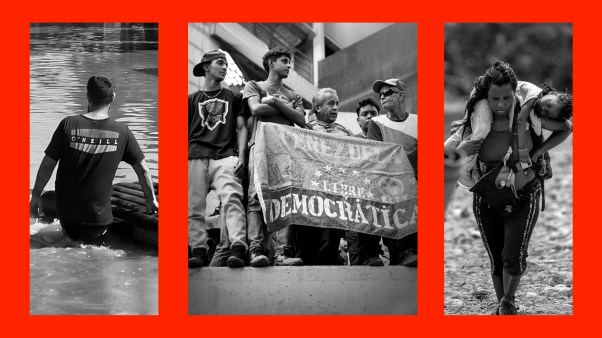I had never heard of Ernst Lohmeyer until I was in my late 20s. I came across his name in the same way I came across many names at the time—as another scholar whom I needed to consult in doctoral research.
Between the Swastika and the Sickle: The Life, Disappearance, and Execution of Ernst Lohmeyer
Eerdmans
344 pages
$28.45
In the mid-1970s, I was writing my dissertation on the Gospel of Mark in the McAlister Library at Fuller Theological Seminary in Pasadena, California. A premier commentary on Mark at the time was Ernst Lohmeyer’s Evangelium des Markus (Gospel of Mark), published in the acclaimed Meyer Commentary Series in Germany. Lohmeyer first published the commentary in 1936 when he was professor of New Testament at the University of Greifswald in Germany. The edition I was using, however, was published in 1967 and accompanied by a supplementary booklet. It carried the name Gerhard Sass, was dated 1950, and mentioned “how continuously [Lohmeyer had] labored to improve and expand his book, until a higher power carried him off to a still-unresolved fate.”
The melancholy of Sass’s preface haunted me. Why, after all these years, was the mystery still unsolved? The note about Lohmeyer’s mysterious disappearance stayed with me by the sheer power of its intrigue. But I did not pursue it. I was married at the time. My wife, Jane, and I had two young children, and my work as youth minister at First Presbyterian Church in Colorado Springs was a full-time-plus call. In addition, my PhD work at Fuller entailed flying to Pasadena three times a year to research assiduously in the library for two weeks. I had no leisure to pursue the lead.
In June 1979, however, his name came up again. I was translating for a Berlin Fellowship team in Greifswald, East Germany. We were in our final meeting, enjoying Kaffee und Kuchen—coffee and cake—in dicke Maria—“Fat St. Mary”— as the rather squat-looking church was affectionately called. The church basement was filled to capacity with people interested in hearing and talking with American visitors. Those who attended did so at some risk to themselves, for the Stasi—secret police—disapproved of public gatherings that were not controlled by the state. During a pause in the discussion, I suddenly interjected. “Is not Greifswald where Ernst Lohmeyer taught? Does anyone know what happened to him?”
The warmth and conviviality suddenly drained from the gathering. I had no idea why. The pastor of Fat St. Mary, Reinhart Glöckner, brought the meeting to a hasty and awkward conclusion and said to me, “Jim, let’s take a walk.” In a society where listening devices were placed in radios and TVs, in light sockets and under reception counters, where social settings such as this invariably had listening ears, a walk usually guaranteed privacy. We walked along a street called Brüggstrasse to the point where it exited through the old city walls. There we took a right and walked along a gravel path. On our right was the old red-brick city wall, on our left a spacious and inviting bank of trees. I felt anxious as we walked.
“Lohmeyer disappeared at the hands of the communists,” Gloeckner said in veiled exasperation. “He was certainly killed by them, although we do not know any details. People who are arrested and liquidated by the state are considered enemies of the state, and whoever inquires about their fate is considered an accomplice. Accomplices are enemies of the state. Your question jeopardized everyone in the room this afternoon!”
I was left smarting. Glöckner’s explanation made sense, although I confess that its force would have been lost on me apart from his rebuke. But more important than the rebuke was the monstrous injustice of the cover-up itself. For 33 years the murder of an innocent man had been cloaked in silence. I was indignant. “Surely his death can be resolved,” I said. “Lohmeyer was a great theologian. He was even the president of the university here. How can he be consigned to oblivion in the city where it all took place?”
Glöckner was as concerned with Lohmeyer’s fate as I was. Probably more so. But he was an East German pastor and not free to consider Lohmeyer’s story in isolation from the existential realities of his parish—a parish, like all churches in East Germany, that had to find a way to live within the confines of an all-encompassing state that sought to suppress and ultimately eradicate its existence. But I could.
Over three decades that spanned the fall of the Berlin wall, I researched Lohmeyer, made trips back and forth to Berlin, unearthed archives, and slowly put together the pieces. What emerged was the portrait of a man who, not unlike Dietrich Bonhoeffer and others of his generation in Germany, found himself commandeered by forces beyond his control.
Lohmeyer opposed authoritarian Nazi ideology, especially its fanatical anti-Semitism. He affiliated with the Confessing Church, a branch of the German Protestant Church that resisted the annexation of the church by the state. Through it all, he held steadfastly to his vocation as a biblical theologian. He wrote voluminously in his academic life—a dozen scholarly books, half again that number of scholarly articles, and nearly 50 reviews of prominent books—but also in works closer to his soul, in sermons, correspondence with intellectual luminaries of the day, and letters to his wife during nine and a half years of service in World Wars I and II. His character and brilliance resulted in his being named president of not one but two German universities.
Lohmeyer’s mettle and faith were tested to their limits first in Nazi Germany and subsequently in communist East Germany. When Soviet military operatives labeled him “enemy of the state” and murdered him in 1946, it was their intention not simply to take his life but to expunge all memory of him, als ob er nie existierte—“as though he never existed.”
Decades before his death and at the height of his scholarly life, Lohmeyer had turned to the subject of martyrdom. The fullest development of his thoughts on the subject came in a 1928 commentary on Philippians in the Meyer series. The structure and content of Philippians, maintained Lohmeyer, were determined by martyrdom: comfort in martyrdom, dangers attending martyrdom, and admonitions in the face of martyrdom.
Lohmeyer regarded Philippians 3:10 as a capsule of the entire epistle, as well as the claim of the gospel on church and believer: “That I may know Jesus Christ and the power of his resurrection, and may share his sufferings, becoming like him in his death.” Martyrdom was the irreducible kernel of Christianity because it was the essential link between the gospel and the world. In martyrdom, the Christian individual and the church collectively testify to the essence of the gospel with a purity and totality that they nowhere else render for the gospel. And also in martyrdom, the world witnesses and experiences the truth and power of the gospel in a way and to a degree that it nowhere else witnesses and experiences the gospel.
It is tempting to read Lohmeyer’s early and atypical interest in martyrdom in light of his own fate 20 years later. Did he have a personal premonition of what awaited him? Or did he perhaps see in martyrdom a prophetic witness to the church? The answer to these questions is almost certainly negative. To interpret Lohmeyer’s discussion of martyrdom as a closet reference to himself would be to misjudge both his character and his purpose as a theologian. Nonetheless, his death fulfilled martyrdom just as he envisioned it: As a witness who drew a link between the gospel and the world.
The half-century blackout on his fate, the puzzle of his “mysterious disappearance and death,” as Gerhard Sass referred to it, had at last been resolved—at least as far as human resources can resolve such things. And his story, like many who resisted Nazi and Communist repression, points toward Christ.
For most of his life, Lohmeyer had read the daily Bible readings of the Herrnhuter Brethren in Germany. The reading for September 19, 1946, his death day, was Mark 7:37, “[Jesus] has done all things well.” Lohmeyer found this verse particularly rich and meaningful. In his Mark commentary, he wrote about verse 37 as follows: “In Jesus … the eschatological fulfillment of what from the very beginning had been a long and dark history of God’s people is at hand. Here is the fulfillment of Old Testament eschatological prophecy.”
“[Jesus] has done all things well.” Lohmeyer’s death was the fulfillment of the same hope.
James R. Edwards is the Bruner-Welch Professor Emeritus of Theology at Whitworth University. He is the author of Is Jesus the Only Savior? and Between the Swastika and the Sickle: The Life, Disappearance, and Execution of Ernst Lohmeyer (Eerdmans, 2019), as well as commentaries on Romans and the Gospels of Mark and Luke. CT’s review of the Lohmeyer biography is available here.This essay was adapted from Between the Swastika and the Sickle by James R. Edwards ©2019 (Wm. B. Eerdmans Publishing Co.) Reprinted by permission of the publisher; all rights reserved.










